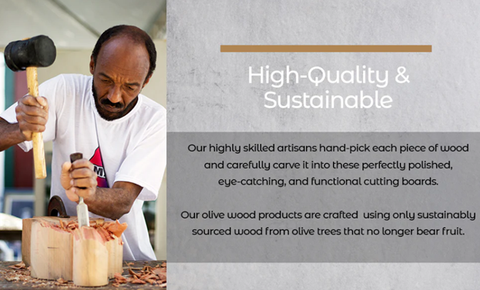In recent years, there has been a growing concern for the environment and sustainability. People are looking for ways to reduce their carbon footprint and live a more sustainable lifestyle. One of the ways to do this is by choosing products that are made from sustainable materials. One such product is the olive wood cutting board. In this article, we will explore the environmental impact of olive wood cutting boards and why they are a sustainable choice. In this article, we will explore the benefits of olive wood cutting boards, how they are made, and how to care for them.
Sustainability of Olive Wood
Olive wood is a sustainable material that is environmentally friendly. Olive trees are known to grow in regions with hot, dry climates, such as the Mediterranean. These trees are also known to be hardy and can withstand harsh weather conditions. The fact that olive trees grow in these regions means that they require minimal irrigation, making them a great choice for sustainable materials.
In addition, olive trees are not only grown for their fruit but also for their wood. The wood from these trees is a by-product of olive farming. Instead of burning or disposing of the wood, it is used to create a range of products, including cutting boards. This process of using the by-product of olive farming reduces waste and supports sustainable practices.

Why Choose an Olive Wood Cutting Board?
There are several reasons to choose an olive wood cutting board over other types of cutting boards.
- Unique and Attractive Design: Olive wood cutting boards have a distinct and eye-catching design that makes them stand out in the kitchen. Unlike other types of wood, olive wood has a unique and attractive grain pattern that makes it a popular choice for cutting boards and other kitchen utensils. Additionally, the dense and durable nature of the wood means that olive wood cutting boards can withstand heavy use and last for many years without needing to be replaced.
- Durable and Long-Lasting: Olive wood is a dense and durable wood that is resistant to scratches and wear and tear. This makes it an ideal material for cutting boards that will be used regularly in the kitchen. With proper care, an olive wood cutting board can last for years.
- Naturally Antibacterial: Olive wood has natural antibacterial properties that make it a hygienic choice for a cutting board. The wood's porous surface prevents bacteria from penetrating deep into the wood, making it easy to clean and sanitize.
- Environmentally Friendly: Olive wood is an environmentally friendly material. Olive trees are a sustainable crop that requires minimal resources to grow. Using olive wood products helps support sustainable farming practices and reduces waste.
How is Olive Wood Cutting Boards Made?
Olive wood cutting boards are made from the wood of an olive tree. The wood is harvested from trees that are no longer producing olives or from the pruning of younger trees. The wood is then dried and cut into the desired shape and size. The cutting board is then sanded and finished with a food-grade oil to protect the wood and enhance its natural beauty.

Comparison to Other Cutting Board Materials
When compared to other cutting board materials, olive wood cutting boards are a better choice for the environment. Plastic cutting boards are not biodegradable and can take hundreds of years to decompose. In addition, plastic cutting boards can harbor bacteria and other harmful microorganisms, making them less hygienic than olive wood cutting boards.
Bamboo cutting boards are another popular choice for sustainability. While bamboo is a renewable resource, it requires a lot of water to grow, which can lead to water scarcity in certain regions. In addition, the process of turning bamboo into cutting boards involves the use of chemicals, which can be harmful to the environment.
Olive wood cutting boards are a better choice for the environment as they are made from a by-product of olive farming, which reduces waste. In addition, olive trees require minimal irrigation, making them a sustainable choice for materials.
How to Care for Your Olive Wood Cutting Board
To keep your olive wood cutting board looking its best, follow these care tips:
- Clean after each use: After each use, clean the cutting board with soap and water. Rinse thoroughly and dry with a clean towel.
- Oil regularly: To protect the wood and enhance its natural beauty, oil the cutting board with a food-grade oil every few weeks. Apply a thin layer of oil to the entire surface of the board and let it soak in for several hours or overnight.
- Avoid soaking: Do not soak your olive wood cutting board in water as it can cause the wood to warp and crack.
- Store properly: Store your olive wood cutting board in a dry and cool place away from direct sunlight. Do not stack heavy items on top of the board.

Conclusion
An olive wood cutting board is a versatile, functional, and attractive kitchen tool that can last for years with proper care. The unique design and durability of olive wood make it a popular choice for home cooks and chefs alike. By following a few simple care tips, you can keep your olive wood cutting board looking its best for years to come.
At Choixe, we are committed to sustainability and responsible sourcing, and our olive wood cutting boards are a reflection of this commitment. Our cutting boards are handmade by skilled artisans in Tunisia, where the tradition of olive wood carving has been passed down through generations. By purchasing a Choixe olive wood cutting board, you are not only supporting a sustainable and eco-friendly product but also supporting the livelihoods of these artisans and their communities.

